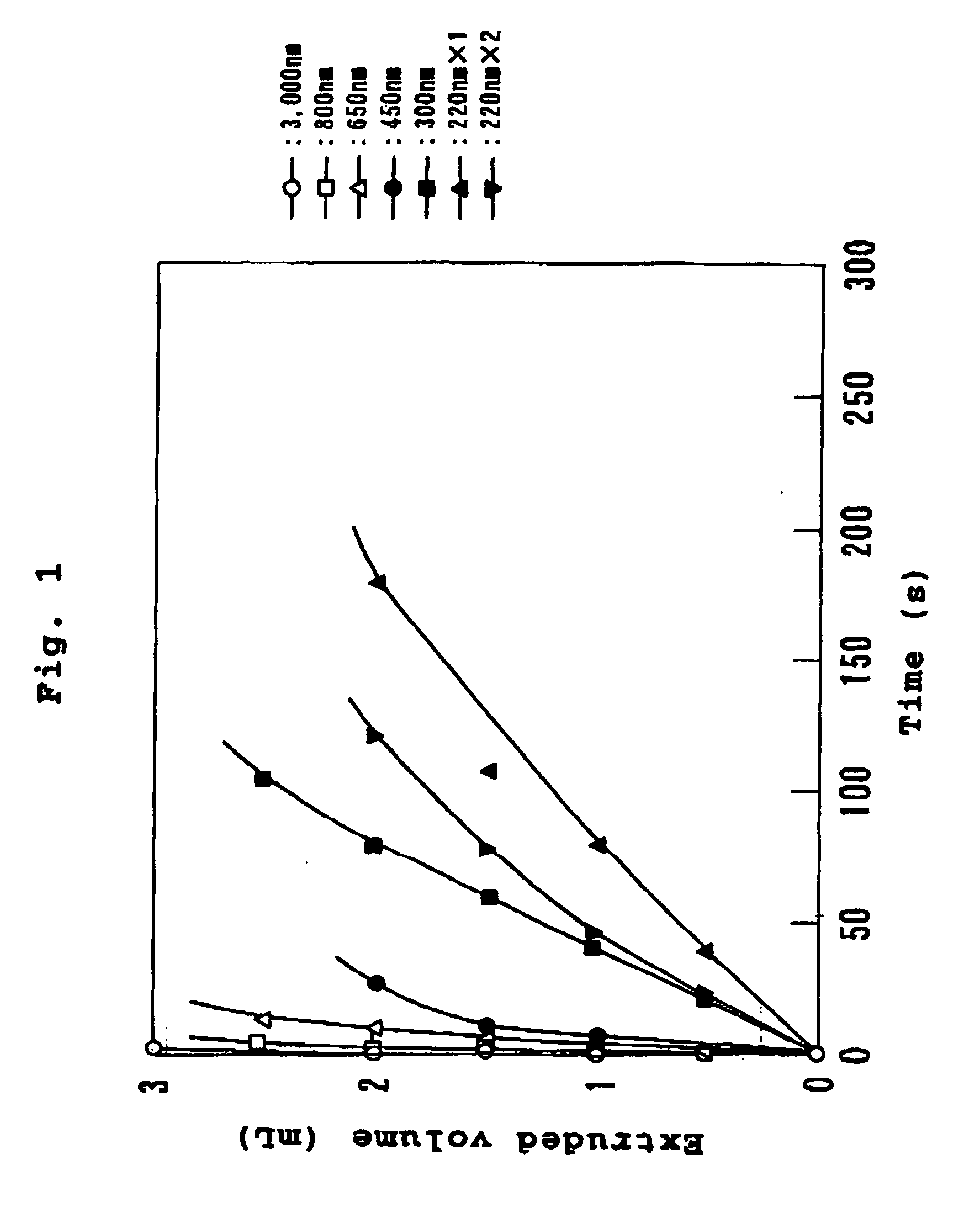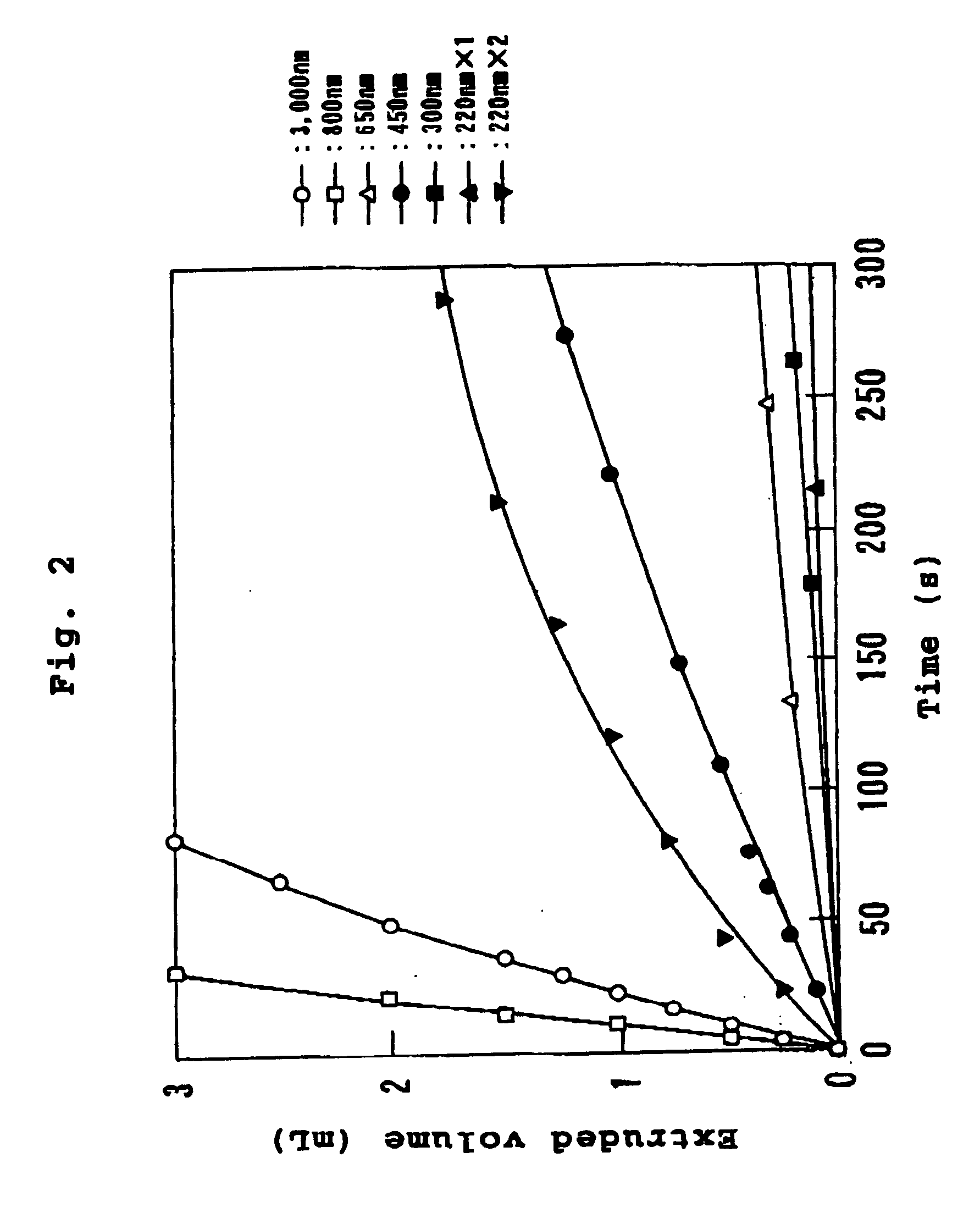Method for preparing microsome dispersion
a microsome and dispersion technology, applied in the field of preparation of microsome dispersions, can solve the problems of low encapsulation efficiency, difficult dispersal of lipid components that construct bilayer membranes, and wide size distribution of resulting vesicles, and achieve safe and simple encapsulation of substances, high yield, and high efficiency
- Summary
- Abstract
- Description
- Claims
- Application Information
AI Technical Summary
Benefits of technology
Problems solved by technology
Method used
Image
Examples
example 1
[0043] A mixed lipid consisting of 144 mg (0.2 mmol) of dipalmitoylphosphatidylcholine, 76 mg (0.2 mmol) of cholesterol and 29 mg (0.04 mmol) of dipalmitoylphosphatidylglycerol was dispersed in 5 mL of water for injection as membrane lipids, and stirred at25.degree. C. to obtain a multi-lamellar vesicle dispersion. This dispersion was subjected to three cycles of freeze-thawing wherein the dispersion was frozen with liquid nitrogen and thawed at 25.degree. C., to obtain a dispersion of 500 nm vesicles. This vesicle dispersion was spray-dried to obtain dried vesicles. The lyophilized vesicles were added to 5 mL (35 g / dL) of hemoglobin solution, which was stirred at 25.degree. C. for 2 hours. This was then subjected to an EXTRUDER (registered trademark) (trade name, manufactured by Nichiyu Liposome), and successively extruded through acetylcellulose filters (manufactured by Fuji Photo Film Co., Ltd.) of pore sizes 3.0 .mu.m, 0.8 .mu.m, 0.65 .mu.m, 0.45 .mu.m, 0.30 .mu.m and 0.22 .mu.m...
example 2
[0054] A mixed lipid consisting of 432 mg (0.6 mmol) of dipalmitoylphosphatidylcholine, 228 mg (0.6 mmol) of cholesterol and 87 mg (0.12 mmol) of dipalmitoylphosphatidylglycerol was dispersed in 15 mL of water for injection, as membrane lipids, and stirred at 25.degree. C. to obtain a multi-lamellar vesicle dispersion. This dispersion was separated into three 5 mL portions and subjected to (a) a system wherein particle size adjustment by pre-treatment is not performed, (b) a system wherein the particle size is adjusted to 500 nm by extrusion, and (c) a system wherein the particle size is adjusted to 250 nm by extrusion, which were then frozen with liquid nitrogen, fitted to a lyophilizer, and freeze-dried for 12 hours to obtain lyophilized vesicles.
[0055] 5 mL (35 g / dL) of a stroma-free hemoglobin solution was added to each sample, and stirred at 14.degree. C. for 2 hours to obtain a hemoglobin vesicle dispersion.
[0056] This was then subjected to an EXTRUDER (registered trademark) (...
example 3
[0063] As the vesicle membrane lipid, 144 mg (0.2 mmol) of dipalmitoylphosphatidylcholine, 76 mg (0.2 mmol) of cholesterol, 29 mg (0.04 mmol) of dispalmitoylphosphatidylglycerol and 7 mg (1.3 .mu.mol) of distearoyl-N-monomethoxy-polyethyleneglycol (molecular weight: 5,000)-succinylphosphatidylethanolamine were weighed, and added to a 10 mL flask. 5 mL of benzene was added thereto, and the lipid was completely dissolved under heating. This solution was frozen with liquid nitrogen, fitted to a lyophilizer, and freeze-dried for 12 hours to obtain a white powder. This powder was added to 5 mL of water for injection, and stirred at 25.degree. C. to obtain a vesicle dispersion with a vesicle size of 1.8 .mu.m. This dispersion was subjected to four cycles of freeze-thawing, consisting of freezing with liquid nitrogen and thawing at 25.degree. C., whereby a dispersion of 520 nm vesicles was obtained. This dispersion was frozen with liquid nitrogen, fitted to a lyophilizer, and freeze-dried ...
PUM
 Login to View More
Login to View More Abstract
Description
Claims
Application Information
 Login to View More
Login to View More - R&D
- Intellectual Property
- Life Sciences
- Materials
- Tech Scout
- Unparalleled Data Quality
- Higher Quality Content
- 60% Fewer Hallucinations
Browse by: Latest US Patents, China's latest patents, Technical Efficacy Thesaurus, Application Domain, Technology Topic, Popular Technical Reports.
© 2025 PatSnap. All rights reserved.Legal|Privacy policy|Modern Slavery Act Transparency Statement|Sitemap|About US| Contact US: help@patsnap.com


